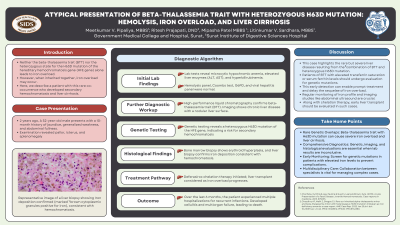Monday Poster Session
Category: Liver
P3017 - Atypical Presentation of Beta-Thalassemia Trait with Heterozygous H63D Mutation: Hemolysis, Iron Overload, and Liver Cirrhosis
Monday, October 28, 2024
10:30 AM - 4:00 PM ET
Location: Exhibit Hall E

Has Audio
- MP
Mipasha Patel, MBBS
Government Medical College and Hospital
Berlin, NJ
Presenting Author(s)
Meetkumar V.. Pipaliya, MBBS1, Ritesh Prajapati, MBBS, MD2, Mipasha Patel, MBBS1, Litinkumar V.. Sardhara, MBBS1
1Government Medical College and Hospital, Surat, Gujarat, India; 2SIDS Hospital and Research Center, Surat, Gujarat, India
Introduction: Neither the beta-thalassemia trait (BTT) nor the heterozygous state for the H63D mutation of the hereditary hemochromatosis gene (HFE gene) alone leads to iron overload. However, when inherited together, iron overload may occur. Here, we describe a patient with this rare co-occurrence who developed secondary hemochromatosis and liver cirrhosis.
Case Description/Methods: A 52-year-old Indian male presented with a 10-month history of jaundice, generalized weakness, and abdominal fullness 2 years ago. He had no past history of blood transfusions or alcohol consumption. Examination revealed pallor, icterus, and splenomegaly. The patient initially presented with microcytic hypochromic anemia, elevated liver enzymes, and hyperbilirubinemia, suggestive of hemolytic anemia and paradoxically high ferritin and low TIBC. The hemolysis panel, Coombs test, G6PD, and serum osmotic fragility were normal. The viral hepatitis panel was negative. High-performance liquid chromatography suggested BTT and was treated accordingly. Radioimaging revealed chronic liver disease with a nodular liver surface. During a 2-year follow-up, the patient remained symptomatic and had a significant weight loss. Further workup for autoimmune liver disease and Wilson's disease was negative. Heavy metal deposition in the liver presented as hypointense on Magnetic Resonance cholangiopancreatography. Bone marrow biopsy indicated marked erythroid hyperplasia and reduced iron suggestive of hemolysis and liver biopsy revealed marked brown cytoplasmic granules positive for iron suggestive of hemochromatosis. Genetic evaluation confirmed H63D heterozygous mutation in this patient, who also had BTT accompanied by significant hemolysis and iron overload. Deferasirox was started, and the need for a liver transplant was considered. During the last six months of follow-up, the patient required multiple hospitalizations for recurrent infections and eventually developed cellulitis with multiorgan failure, leading to death.
Discussion: This case highlights the rare but severe liver disease resulting from the combination of BTT and heterozygous H63D mutation. Patients of BTT with elevated transferrin saturation or serum ferritin levels should undergo evaluation for genetic mutations. This early detection can enable prompt treatment and delay the sequelae of iron overload. Regular monitoring of iron profile and imaging studies like abdominal ultrasound are crucial. Along with Chelation therapy, early liver transplant should be evaluated in such cases.
Disclosures:
Meetkumar V.. Pipaliya, MBBS1, Ritesh Prajapati, MBBS, MD2, Mipasha Patel, MBBS1, Litinkumar V.. Sardhara, MBBS1. P3017 - Atypical Presentation of Beta-Thalassemia Trait with Heterozygous H63D Mutation: Hemolysis, Iron Overload, and Liver Cirrhosis, ACG 2024 Annual Scientific Meeting Abstracts. Philadelphia, PA: American College of Gastroenterology.
1Government Medical College and Hospital, Surat, Gujarat, India; 2SIDS Hospital and Research Center, Surat, Gujarat, India
Introduction: Neither the beta-thalassemia trait (BTT) nor the heterozygous state for the H63D mutation of the hereditary hemochromatosis gene (HFE gene) alone leads to iron overload. However, when inherited together, iron overload may occur. Here, we describe a patient with this rare co-occurrence who developed secondary hemochromatosis and liver cirrhosis.
Case Description/Methods: A 52-year-old Indian male presented with a 10-month history of jaundice, generalized weakness, and abdominal fullness 2 years ago. He had no past history of blood transfusions or alcohol consumption. Examination revealed pallor, icterus, and splenomegaly. The patient initially presented with microcytic hypochromic anemia, elevated liver enzymes, and hyperbilirubinemia, suggestive of hemolytic anemia and paradoxically high ferritin and low TIBC. The hemolysis panel, Coombs test, G6PD, and serum osmotic fragility were normal. The viral hepatitis panel was negative. High-performance liquid chromatography suggested BTT and was treated accordingly. Radioimaging revealed chronic liver disease with a nodular liver surface. During a 2-year follow-up, the patient remained symptomatic and had a significant weight loss. Further workup for autoimmune liver disease and Wilson's disease was negative. Heavy metal deposition in the liver presented as hypointense on Magnetic Resonance cholangiopancreatography. Bone marrow biopsy indicated marked erythroid hyperplasia and reduced iron suggestive of hemolysis and liver biopsy revealed marked brown cytoplasmic granules positive for iron suggestive of hemochromatosis. Genetic evaluation confirmed H63D heterozygous mutation in this patient, who also had BTT accompanied by significant hemolysis and iron overload. Deferasirox was started, and the need for a liver transplant was considered. During the last six months of follow-up, the patient required multiple hospitalizations for recurrent infections and eventually developed cellulitis with multiorgan failure, leading to death.
Discussion: This case highlights the rare but severe liver disease resulting from the combination of BTT and heterozygous H63D mutation. Patients of BTT with elevated transferrin saturation or serum ferritin levels should undergo evaluation for genetic mutations. This early detection can enable prompt treatment and delay the sequelae of iron overload. Regular monitoring of iron profile and imaging studies like abdominal ultrasound are crucial. Along with Chelation therapy, early liver transplant should be evaluated in such cases.
Disclosures:
Meetkumar Pipaliya indicated no relevant financial relationships.
Ritesh Prajapati indicated no relevant financial relationships.
Mipasha Patel indicated no relevant financial relationships.
Litinkumar Sardhara indicated no relevant financial relationships.
Meetkumar V.. Pipaliya, MBBS1, Ritesh Prajapati, MBBS, MD2, Mipasha Patel, MBBS1, Litinkumar V.. Sardhara, MBBS1. P3017 - Atypical Presentation of Beta-Thalassemia Trait with Heterozygous H63D Mutation: Hemolysis, Iron Overload, and Liver Cirrhosis, ACG 2024 Annual Scientific Meeting Abstracts. Philadelphia, PA: American College of Gastroenterology.
